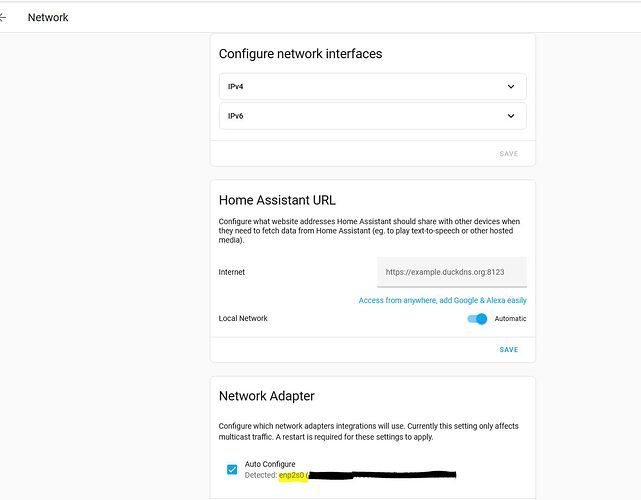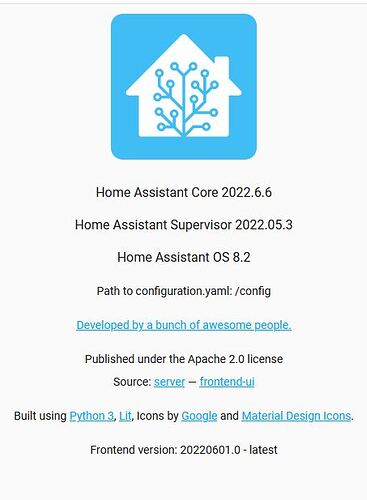According to this video tutorial I’ve set up some cpu, memory and network monitoring entities, which all work fine except the networking ones.ip addr command, the output should be something like eth0 or similiar. In my case, it gives me back eth0@if21, which won’t work. When I put in into the config.yaml file like this…
# Sensors:
sensor:
- platform: systemmonitor
resources:
- type: throughput_network_in
arg: eth0@if21
- type: throughput_network_out
arg: eth0@if21
…the entities show up like this:
I’ve also tried to set it between quotation marks like this:arg: 'eth0@if21'@ char like this:arg: 'eth0%40if21'arg: eth0
Any suggestions what else to try?
1: lo: <LOOPBACK,UP,LOWER_UP> mtu 65536 qdisc noqueue state UNKNOWN qlen 1000
I’m not sure if the installed nginx proxy add-on is causing the issue. I have configured it like this within the configuration.yaml file:
# NGINX Docker configuration:
http:
use_x_forwarded_for: true
trusted_proxies:
- 172.30.33.0/24
1: lo: <LOOPBACK,UP,LOWER_UP> mtu 65536 qdisc noqueue state UNKNOWN qlen 1000
link/loopback 00:00:00:00:00:00 brd 00:00:00:00:00:00
inet 127.0.0.1/8 scope host lo
valid_lft forever preferred_lft forever
20: eth0@if21: <BROADCAST,MULTICAST,UP,LOWER_UP,M-DOWN> mtu 1500 qdisc noqueue state UP
link/ether 02:42:ac:1e:21:01 brd ff:ff:ff:ff:ff:ff
inet 172.30.33.1/23 brd 172.30.33.255 scope global eth0
valid_lft forever preferred_lft forever
tom_l
June 17, 2022, 6:46am
6
Are you using a virtual machine?
Did you try:
sensor:
- platform: systemmonitor
resources:
- type: throughput_network_in
arg: if21
- type: throughput_network_out
arg: if21
Tried it now with your suggestion and it also says Unknown.
Yes, I’m on a virtual machine, aarch64 on ESXi ARM.
tom_l
June 17, 2022, 9:10am
8
What does ifconfig return?
eth0 Link encap:Ethernet HWaddr 02:42:AC:1E:21:01
inet addr:172.30.33.1 Bcast:172.30.33.255 Mask:255.255.254.0
UP BROADCAST RUNNING MULTICAST MTU:1500 Metric:1
RX packets:13066 errors:0 dropped:0 overruns:0 frame:0
TX packets:2695 errors:0 dropped:0 overruns:0 carrier:0
collisions:0 txqueuelen:0
RX bytes:4041237 (3.8 MiB) TX bytes:1959366 (1.8 MiB)
lo Link encap:Local Loopback
inet addr:127.0.0.1 Mask:255.0.0.0
UP LOOPBACK RUNNING MTU:65536 Metric:1
RX packets:0 errors:0 dropped:0 overruns:0 frame:0
TX packets:0 errors:0 dropped:0 overruns:0 carrier:0
collisions:0 txqueuelen:1000
RX bytes:0 (0.0 B) TX bytes:0 (0.0 B)
tom_l
June 17, 2022, 10:52am
10
Then it should just be:
sensor:
- platform: systemmonitor
resources:
- type: throughput_network_in
arg: eth0
- type: throughput_network_out
arg: eth0
just stumbling over this too… no more ipv4 address after having move from aRpi4 to a mini PC.
check the system/network tab and see:
so figured I need to set the argument to:
- type: ipv4_address
arg: enp2s0
However, this doesn’t create the sensor either…
I am also missing out on the processor_temperature sensor btw. that has no arguments, so we’re lost there I guess.
Docs say this needs a hardware sensor, and that should be there, because I can do
- platform: command_line
name: Cpu temp (read)
command: >
read -r val </sys/class/thermal/thermal_zone0/temp;echo ${val}
value_template: >
{{value|multiply(0.001)|round(1)}}
unit_of_measurement: °C
returns in cli are partially identical to the ones popcorn boy reports, bit perfect almost…
sorry for that, it was a c&p error, but correct in my config:
- platform: systemmonitor
resources:
- type: disk_use
arg: /home
- type: disk_use_percent
arg: /home
- type: disk_free
arg: /home
# - type: network_in
# arg: eth0
# - type: network_out
# arg: eth0
# - type: packets_in
# arg: eth0
# - type: packets_out
# arg: eth0
# - type: load_1m
# - type: load_5m
# - type: load_15m
- type: processor_temperature
- type: processor_use
# - type: process
# arg: octave-cli
- type: memory_free
- type: memory_use_percent
- type: memory_use
- type: swap_use_percent
- type: swap_use
- type: swap_free
- type: last_boot
- type: ipv4_address
arg: eth0
tom_l
June 18, 2022, 1:41am
14
What shows on the Settings > System > Network page?
2 Likes
Oh well, that was it!Network adapter on the page you mentioned showed the following different NIC interface description:
So I tried the following for my
configuration.yaml:
# Sensors:
sensor:
- platform: systemmonitor
resources:
- type: throughput_network_in
arg: enp2s0
- type: throughput_network_out
arg: enp2s0
And boom, it worked:
So is that an issue at all that should be sent as an issue ticket to GitHub?
5 Likes
tom_l
June 20, 2022, 8:55am
16
What version number of Home Assistant are you running?
did you also try that on the ipv4 sensor? I did , and it didnt create the sensor.
Sorry but I don’t really get what you mean. I have ipv6 disabled and only ipv4 enabled and the two sensors are being created as you can see on the screenshot above. Maybe I just misunderstand your question.
What I mentioned: You wrote about moving from a Raspi Pi over to a mini PC. I assume you did the migration by restoring from a full backup, which I also did a few weeks ago, just the other way round: I moved from a x86_64 system to aarch64 version of Home Assistant. Maybe the issue of NIC name inconsistencies is being created when migrating from one system to another?
I meant to ask did you also add
- type: ipv4_address
arg: enp2s0
to the system_monitor config.
all other configured sensors work, as posted above, so I dont think it has to do with migration.





